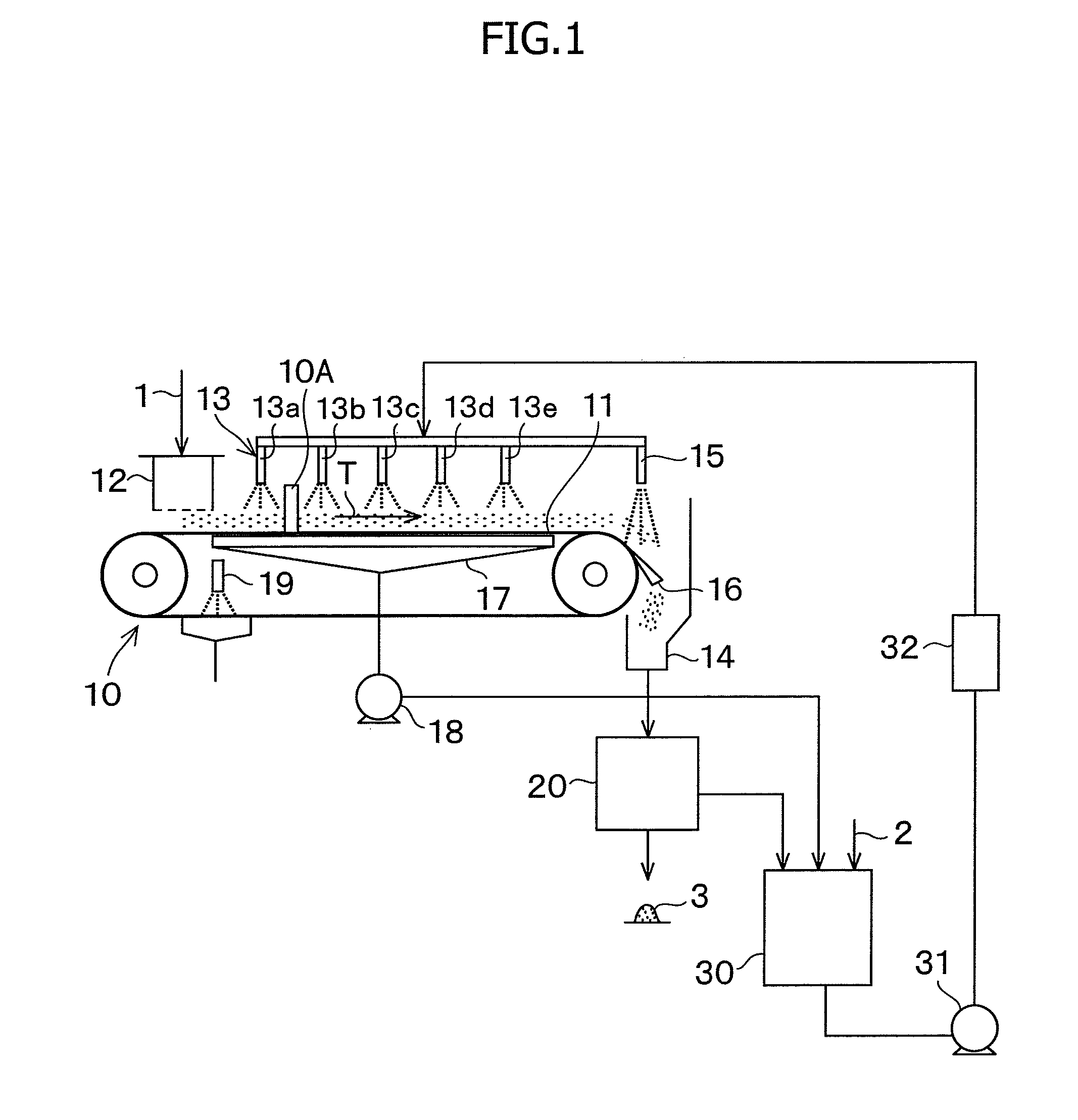Methods for preparing alkali cellulose and cellulose ether
a technology of cellulose ether and alkali cellulose, which is applied in the direction of liquid gas reaction process, chemical apparatus and processes, chemical/physical processes, etc., can solve the problems of undissolved portion, lack of uniform distribution of alkali in pulp, and inability to uniformly distribute alkali, etc., to achieve efficient preparation and high transparency
- Summary
- Abstract
- Description
- Claims
- Application Information
AI Technical Summary
Benefits of technology
Problems solved by technology
Method used
Image
Examples
example 1
[0067]Pulp chips derived from wood and having a solid component concentration of 93% by weight, each of the chips being of 10 mm square, were introduced at a rate of 60 kg / hour to one end of a horizontal belt type vacuum filter of 0.2 m wide and 1.0 m long. As a filtering material, a perforated metal belt having a thickness of 1 mm and holes with a diameter of 2 mm was used. The moving speed of the belt was 0.025 m / s. Spraying nozzles were provided at 0 m, 0.2 m, 0.4 in, 0.6 m and 0.8 m in the moving direction and 2 cm, 6 cm, 10 cm, 14 cm and 18 cm from one end on a straight line in the width direction. An aqueous 49% by weight sodium hydroxide solution of 40° C. was sprayed at a spraying rate of 120 L / hour per nozzle. At the same time, the aqueous 49% by weight sodium hydroxide solution which had passed through a cake layer was suctioned from a filtration plane. Screw type leveling devices, each having a function of controlling a height level and gathering a contact product between...
example 2
[0070]Alkali cellulose was prepared in the same manner as in Example 1 except that the moving speed of the belt was 0.033 m / sec, a Wade type leveling device was used instead, and a screw discharge type centrifugal dehydrator having a centrifugal effect of 600 as a drainer was placed at the outlet of the continuous horizontal vacuum filter.
[0071]A weight ratio of the alkali metal hydroxide in the resulting alkali cellulose to the solid component in the pulp was determined by the titration method and found to be 1.00.
[0072]The alkali cellulose (17.2 kg) was placed in a pressure-resistant reactor and after vacuuming, it was reacted with 9 kg of methyl chloride and 1.4 kg of propylene oxide. The reaction product was washed, dried and pulverized to obtain hydroxypropylmethyl cellulose.
[0073]The hydroxypropylmethyl cellulose thus obtained had a methoxy group (DS) of 1.80 and a hydroxypropoxy group (MS) of 0.14. An aqueous 2% by weight solution of the hydroxypropylmethyl cellulose had a vi...
example 3
[0074]Alkali cellulose was prepared in the same manner as in Example 1 except that spraying from the spraying nozzles at 0 m, 0.2 In, and 0.4 m in the moving direction was omitted and an extrusion plate type centrifugal dehydrator with a 0.2 mm slit screen having a centrifugal effect of 600 as a drainer was placed at the outlet of the continuous horizontal vacuum filter.
[0075]A weight ratio of the alkali metal hydroxide in the resulting alkali cellulose to the solid components in the pulp was determined by the titration method and found to be 0.70.
[0076]The alkali cellulose (18.8 kg) was placed in a pressure-resistant reactor and after vacuuming, it was reacted with 9 kg of methyl chloride and 2.5 kg of propylene oxide. The reaction product was washed, dried and pulverized to obtain hydroxypropylmethyl cellulose. The resulting hydroxypropylmethyl cellulose had a methoxy group (DS) of 1.45 and a hydroxypropoxy group (MS) of 0.20. An aqueous 2% by weight solution of the hydroxypropylm...
PUM
| Property | Measurement | Unit |
|---|---|---|
| height | aaaaa | aaaaa |
| particle size | aaaaa | aaaaa |
| area | aaaaa | aaaaa |
Abstract
Description
Claims
Application Information
 Login to View More
Login to View More - R&D
- Intellectual Property
- Life Sciences
- Materials
- Tech Scout
- Unparalleled Data Quality
- Higher Quality Content
- 60% Fewer Hallucinations
Browse by: Latest US Patents, China's latest patents, Technical Efficacy Thesaurus, Application Domain, Technology Topic, Popular Technical Reports.
© 2025 PatSnap. All rights reserved.Legal|Privacy policy|Modern Slavery Act Transparency Statement|Sitemap|About US| Contact US: help@patsnap.com


